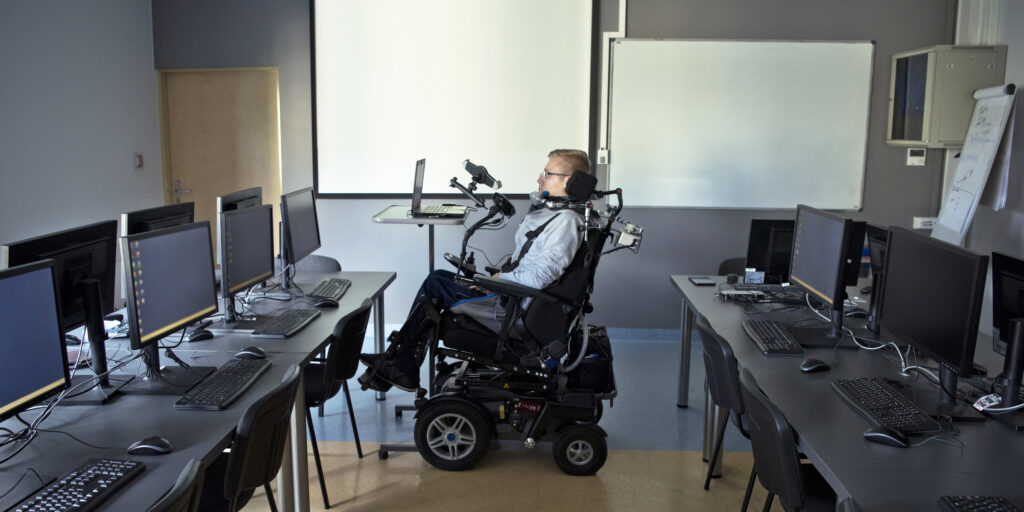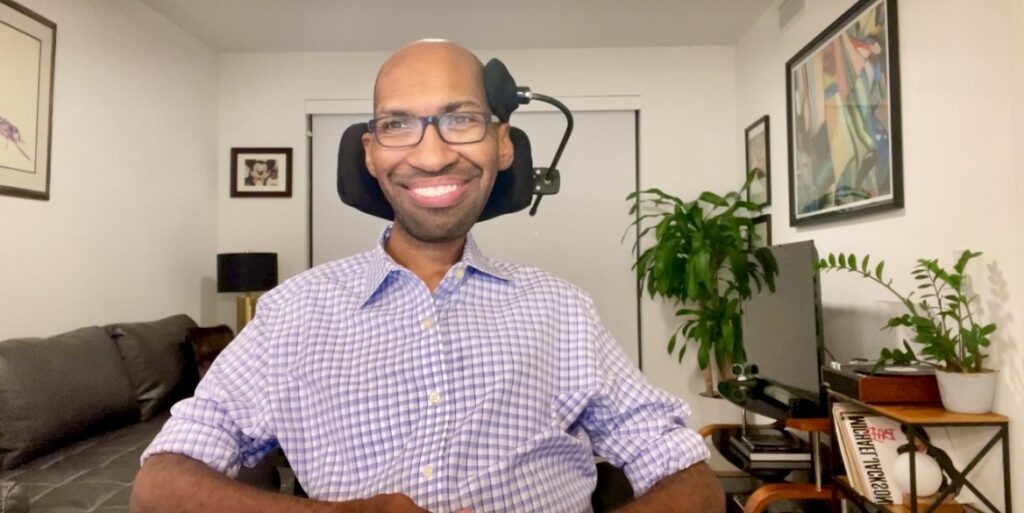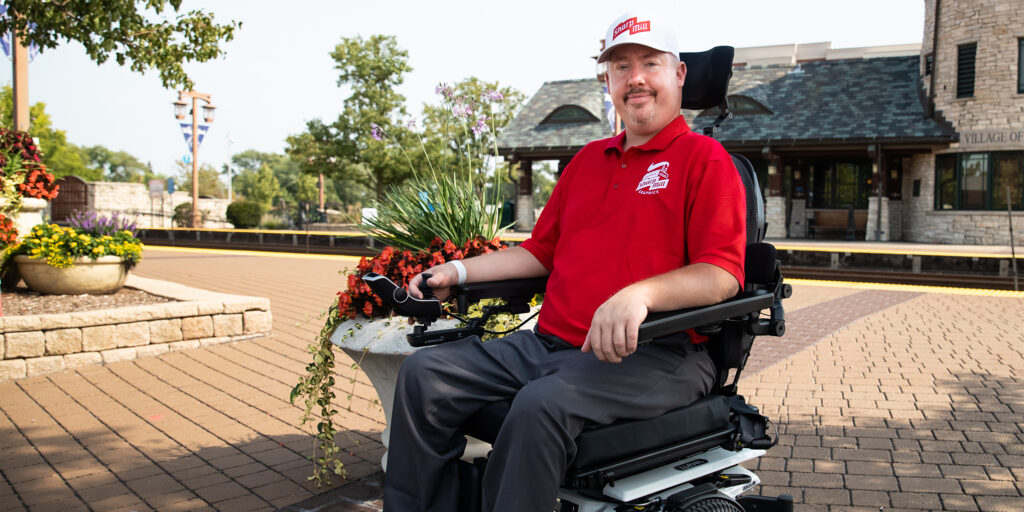
Passion and Purpose Unite for Certified Disability-Owned Business Owner and Branding Manager
By Rebecca Hume | Tuesday, October 22, 2024
5 Second Summary
Read more personal stories from members of the neuromuscular community about their College Experience as they share their journey, accomplishments, advice for accommodations and overcoming barriers, and insights into navigating college life with a disability.
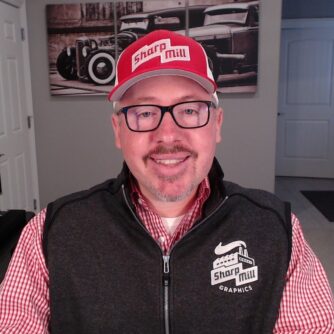
Jeremy Siegers, Owner and President of Sharp Mill Graphics
For Jeremy Siegers, the key to success is combining passion and purpose. What started as a hobby for the 43-year-old living with limb-girdle muscular dystrophy (LGMD) has grown into a lucrative and fulfilling career. As a certified disability-owned business owner, he wants others in the disability community to know that their talents, skills, and gifts are valued and needed in the employment and entrepreneurial world.
Finding his passion
Jeremy was excused from gym class in high school due to the physical limitations of his diagnosis and began taking additional art classes to fill the gap. Those classes sparked a passion as he discovered a liberating interest and ability for art and design. His time in the art studio brought an additional solace to the teenager, who at that time exerted energy hiding his disability from his peers and struggling at times to navigate his large high school in Tinley Park, IL. “When I got into those art classes, I was learning to draw, do ceramics, do graphic arts – I could sit at the desk and be totally calm and relaxed and let my brain do the work,” Jeremy recalls. “I could be creative and not worry about my body holding me back. And unlike gym class or on the football field, I was just as good, if not better, than the other students in art class.”
Jeremy took as many art classes as he could add to his schedule during his four years of high school. Art became a hobby that he was passionate about, that brought him joy, and that also taught him that he has many skills and talents that he can share with the world. As he began to think about college and his future, he also considered the way that his disease would progress throughout the years and sought a career path that would allow him to focus on his abilities, instead of his disability.
“I knew that my muscles would get weaker and that I would need to use a wheelchair eventually,” he says. “I didn’t see a future careerwise in art, like becoming a famous painter. So, I thought what else can I do where if I go to college and get a job, I can sit at a desk and take my body out of the equation? Computers. I started with some research and ended up going to college for network and communications management.”
While pragmatic in his choice of study at DEVRY University, Jeremy still had a strong passion for art and a job offer his freshman year provided an opportunity to see other ways that art exists in the professional world. A friend of his father owned a local sign company in need of extra help and asked if Jeremy would work for the business after school and on weekends. Jeremy’s dad Big Al and John, the business owner, discussed the requirements of the position and that Jeremy would not be able to lift heavy things or walk around the shop for extended periods of time. John confirmed that Jeremy’s tasks could be completed sitting down and set up an accessible space for him.
“I went to work on my first day and walked into the shop, and I was like whoa! This is commercial art. This is it,” Jeremy says. “It’s what I was doing in high school but on the commercial and professional side. This was what businesses needed for advertising and marketing. This was the side of art that you can make money doing. I found my niche in life without even looking for it on that very first day. Before I even learned anything, I knew I loved it.”
Turning passion into profession
In the early 2000s, when Jeremy began to learn and hone his skills, professional signage and branding were created using large screen-printing presses. He was able to sit in a chair behind the press and operate the machine to create products for the shop’s many large projects. “Every day I went home from work and was excited to tell my parents what I made. I always had a cool story to share,” Jeremy says. “I wasn’t coming home and complaining or upset about my disability – I was coming home happy and passionate about something that I could do and that I was thriving at.”
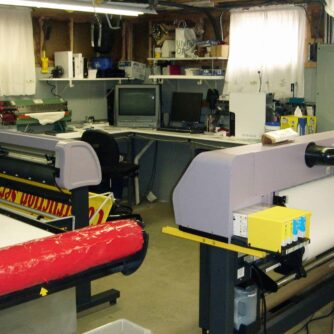
Jeremy’s first sign shop set up in his basement.
After six months of working at the shop, the accounts that Jeremy had been hired to assist with were complete and other family members returned to work at the business. He wanted to find another job that sparked his passion the way that screen-printing had, but there weren’t any available. Jeremy did his own research and discovered that one of the country’s largest distributors for sign-making equipment was hosting a trade show nearby. Jeremy and his dad traveled to the show, where Jeremy purchased equipment to set up his own sign shop in his basement.
“I took the money that I made working at the sign company and invested in myself,” he says. “I bought myself some software and equipment. I would go to college during the day, come home and eat dinner and do my homework, and then go to my set up in the basement every day. Rinse and repeat. I started self-teaching myself how to design on the computer, how to use a plotter, how to start making my own stuff. Being creative. It all started as a hobby.”
College remained his focus, but Jeremy’s graphic design hobby continued to grow, and word started to spread to family and friends. His grandpa owned a wrecking business with large heavy equipment to demolish buildings and asked Jeremy if he would be able to brand and letter some of his trucks and tractors. Jeremy was able to create and design, but he could not physically install the lettering – so he enlisted his dad. Jeremy trained his dad and the two began accepting jobs, with Jeremy designing and directing and his dad installing, and Jeremy’s hobby grew and became a side business that could pay his bills.
“The end game was finishing college and getting a job with my degree and also having my side business. I thought things would go that way, but they didn’t,” Jeremy says. “By the time that I graduated college and started going on interviews, I was using a mobility scooter. I felt like every person I interviewed with only saw my scooter and had the bias that this person with a disability was not going to be dependable, would be taking sick days, need medication, etc. Granted things have changed a lot since the early 2000s, but I interviewed for a solid year trying to get a job with my degree, and nobody would give me a shot. Meanwhile, I was also building my business, where nobody cared about my disability because I was good at what I did.”
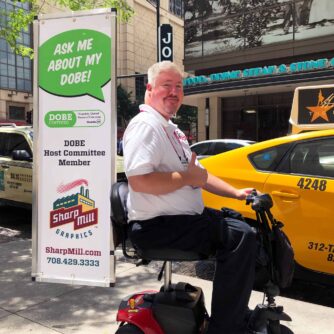
Sharp Mill is a certified disability-owned business nationally with Disability:IN and in the State of Illinois.
After a year of feeling frustrated and discriminated against, Jeremy decided to pursue his printing, promotional, and signage business full-time and create his own success and inclusion. Now, he has been running his certified disability-owned branding management company, Sharp Mill Graphics, for more than 20 years, working with medium-sized and Fortune 500 companies and doing what he loves every day.
Promoting abilities
Jeremy believes that his disability has helped him gain tools along his journey that bolster the talents and skillsets that he brings to the workforce. Both as a creator and as a business owner, he has learned to embrace living with a neuromuscular disease as something that increases certain abilities, instead of something that results in disability.
“For me and other folks with disabilities, we overcome obstacles every day and problem-solve every day, from the moment we wake up to the moment we go to bed,” Jeremy says. “There is always an obstacle or challenge that we have to solve, things that able-bodied people’s brains don’t have to think about. We do it on a daily basis and it makes us extremely incredible problem solvers. Thinking outside the box and overcoming adversity is instilled in us. We were not taught it, we were born with it and had to learn naturally how to do it. And large companies want partners like that.”
In fact, Jeremy has found that large companies seek partners like that. He obtained his certification through Disability:IN, the largest advocate supporter for people with disabilities to get hired by Fortune 500 companies. The organization helps individuals find jobs with large corporations seeking to hire or contract people with disabilities. Disability:IN also is the only national certifier in the United States for businesses owned by people with disabilities, increasing inclusion and diversity with larger companies in their supply chains while providing connections to talented individuals and entrepreneurs with disabilities.
Recognizing the opportunity to create community and support other business owners with disabilities, Jeremy is in the process of launching a social enterprise platform as a subsidiary of Sharp Mill Graphics. While still in the works, Promote Disability will aim to create a brand that amplifies awareness and support for business owners and leaders living with disabilities. He plans to invite fellow business professionals with disabilities to share their stories, to share their passion, and purpose, with the ultimate goal of creating a network that not only spotlights disability-owned businesses but that will speak loudly to the disability – and broader – community to say: We are able to do anything.
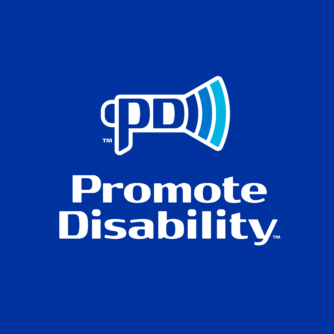
Promote Disability™ will aim to create a brand that amplifies awareness and support for business owners and leaders living with disabilities.
“I want to empower others with disabilities to join the workforce or become entrepreneurs. I want to help them see through other people’s stories that anything is possible. So that they might think, I can’t do some of the things that able-bodied people can do, but I still have opportunities because these people are doing it,” Jeremy says. “I want to help break the barrier of people’s ignorance and misconception about people living with disabilities – we all have something valuable to contribute. When your passion meets your purpose, that can take you wherever you want to go.”
Next Steps and Useful Resources
- Stay up-to-date on Quest content! Subscribe to Quest Magazine and Newsletter.
TAGS: College, College Experience, Community, Employment
TYPE: Blog Post
Disclaimer: No content on this site should ever be used as a substitute for direct medical advice from your doctor or other qualified clinician.


